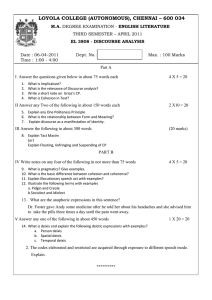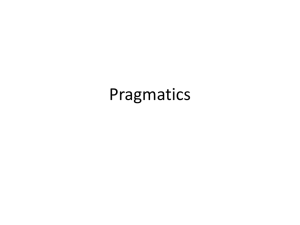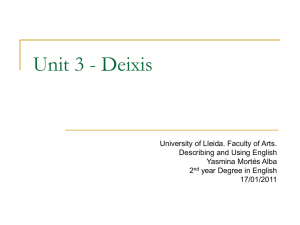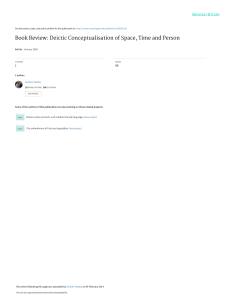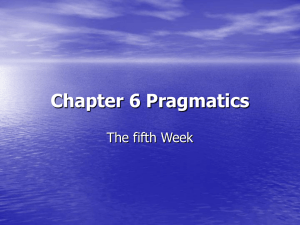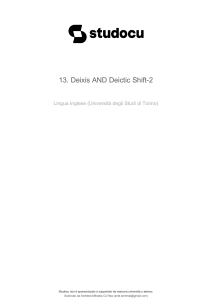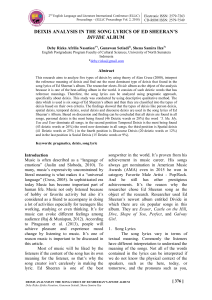deixis and distance
advertisement
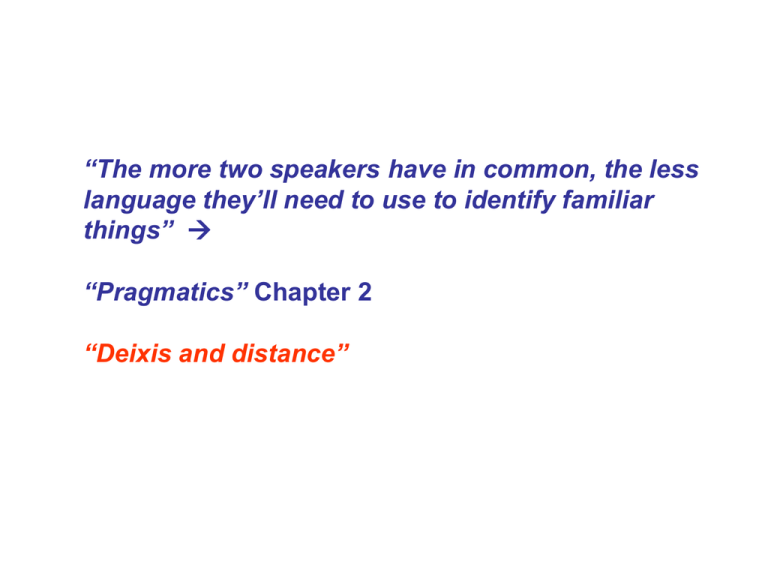
“The more two speakers have in common, the less language they’ll need to use to identify familiar things” “Pragmatics” Chapter 2 “Deixis and distance” Deixis Pointing via language by using deictic expressions or indexicals in utterances. Deixis signals a referent and it relates that referent to a common ground shared by the speaker and the addressee. Typical deictics include this, that, here, and now. All of these words have the ability to situate the speaker and hearer in relation to one another and to the world around them. Deixis is reference by means of an expression whose interpretation is relative to the context of the utterance, such as • who is speaking • the time or place of speaking • the gestures of the speaker • the current location in the discourse • The topic of the discourse Near speaker proximal terms ( this, here, now) Away from speaker distal terms (that, there, then) For example, I is a deictic pronoun because it signals the speaker as the referent . . Another characteristic of deictics such as I and you is that their referents change constantly depending on who is using them. I refers to me when I say it and refers to another person when he/she says it. In this sense, speakers and hearers constantly adjust their internal registry of deictics to keep up with the conversation. News narratives show many examples of deixis: Example 1 - from a CBS Evening News broadcast. 1. The Americans arrested three suspects, but they made many more enemies here, 2. when the soldiers shot back at the gunmen hiding in these houses “Here” (line 1) and “these” (line 2) are two deictic words. These lines are a voice-over accompanying video footage of the village in which the attack occurred. Listeners (viewer and anchor) know that “here” does not mean in their own living room, although that is the point from which the television sound is emanating, but that “here” refers to a location proximal to the speaker. In the same manner, “these houses” is understood to refer to the houses in the video footage. Example 2 1. But it’s clear the situation here could grow far worse 2. before the U.S. even has a chance to win it. In this case, “here” is equivalent to “here in Iraq” or possibly “here in Baghdad” due to the context of the previous few sentences, in which the reporter interviews a U.S. general regarding the current situation on the ground. It is clear to all involved that “here” does not mean “here the area that can be seen on the screen around the me [the reporter].” Person deixis I: the speaker You: the addressee He, she, it : neither speaker, nor addressee Social deixis ( in Italian, “lei” “tu”) social status Spacial deixis Here / There This / That They indicate distance or proximity from the speaker, Physical distance or proximity Mental and psychological distance or proximity (Ex. deictic projection in the direct speech) Temporal deixis Now proximal Then distal (both past and future) Temporal events that move toward us (into view) this weekend Temporal events that move away from us (out of view) Choice of the verb tense Present – proximal form Past – distal form, not only in time but also because unlikely or impossible: Ex: If I had a yacht…. The distal forms of temporal deixis are used to communicate not only distance from current time but also distance from current reality or facts. Conclusion Deictic expressions are in the pragmatics wastebasket Why? Because their interpretation depends on the context, the speaker’s intention, and they express relative distance.
